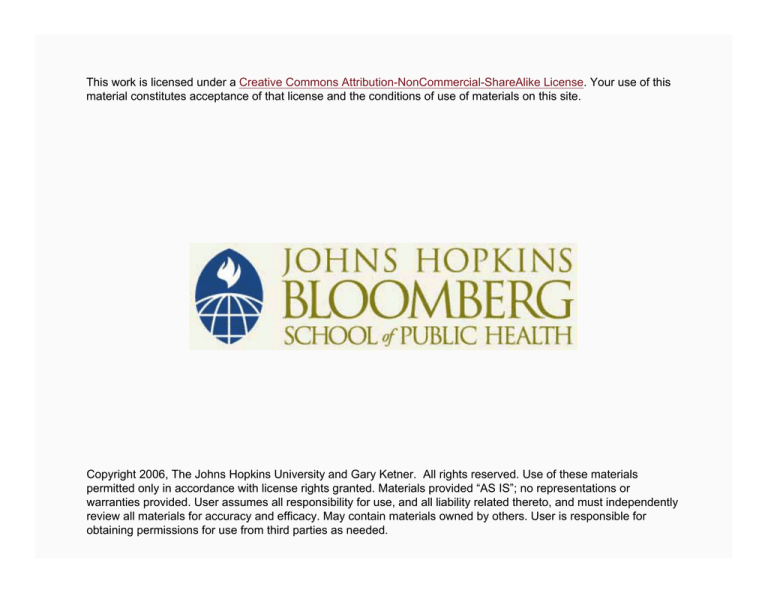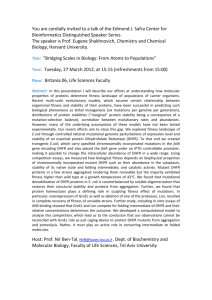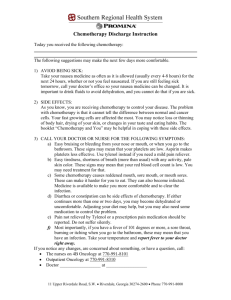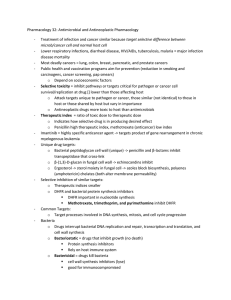
This work is licensed under a Creative Commons Attribution-NonCommercial-ShareAlike License. Your use of this
material constitutes acceptance of that license and the conditions of use of materials on this site.
Copyright 2006, The Johns Hopkins University and Gary Ketner. All rights reserved. Use of these materials
permitted only in accordance with license rights granted. Materials provided “AS IS”; no representations or
warranties provided. User assumes all responsibility for use, and all liability related thereto, and must independently
review all materials for accuracy and efficacy. May contain materials owned by others. User is responsible for
obtaining permissions for use from third parties as needed.
Treatment of Infectious Disease:
Drugs and Drug Resistance
Gary Ketner, PhD
Johns Hopkins University
Section A
History and Principles of Chemotherapy
Chemotherapy of Infectious Disease
Use of chemicals—natural,
synthetic, or semi-synthetic—to
control replication of pathogens
in an infected individual
Chemotherapy generally depends
upon selective toxicity—the
chemicals must be toxic to the
pathogen but not toxic (or less
toxic) for the host
Chemotherapy is used medically
but can also form an element of a
public health effort to control
spread of a disease in a
population
Cinchona succyruba
4
History of Chemotherapy: Robert Koch
Traditional remedies contain
active chemotherapeutic
agents—some still in use
Robert Koch (1860s): the germ
theory of disease
− Provided a target for chemotherapeutic agents
− Introduced the concept of
selectivity for pathogens of
chemicals (dyes)
5
History of Chemotherapy: Paul Erlich
Paul Ehrlich (1908)
− Discovered Salvarsan (606), organic arseniccontaining anti-syphilitic
− Invented a
drug discovery
approach still
used:
systematic
chemical
modification
of a “lead”
compound
6
History of Chemotherapy: Alexander Fleming
Alexander Fleming (1929) discovered penicillin
Florey and Chain (1939) purified penicillin and
demonstrated its use in humans
Penicillium
colony
Staphyllocci
undergoing lysis
Normal
staphylococcal
colony
7
History of Chemotherapy: Domagk and Waksman
Gerhard Domagk
− Sulfanilamide (synthetic) (1934)
Selman Waksman
− Streptomycin (1939)
8
Mechanisms of Drug Action
Drugs are poisons: they work by interfering with an
essential process in a pathogen (for example, DNA,
protein, cell wall synthesis)
− This generally is done by inhibition of function of a
specific protein, preventing a particular chemical
reaction or other event
− Action must be specific for the pathogen
Several drugs, including pyrimethamine, target a step
in utilization of the vitamin folic acid, which indirectly
prevents DNA synthesis
9
dTMP and DNA
DNA synthesis is
essential for
propagation of most
pathogens
DNA synthesis
depends on a supply
of small molecule
precursor
compounds,
including the
nucleoside
monophosphate
dTMP
10
A Biochemical Pathway: Production of dTMP
dTMP is produced by a series of linked bio-chemical
reactions (a biochemical pathway)
− Each arrow represents a chemical reaction
− Starting material and products of the reaction are
indicated at the tails and heads of the arrows
− Reactions are conducted by enzymes, noted
beside the arrow
− Fused arrows indicate reactions that happen in
concert
Continued
11
A Biochemical Pathway: Production of dTMP
Continued
12
A Biochemical Pathway: Production of dTMP
dTMP is produced from dUMP by a reaction that also
converts NN-methylene THF to dihydrofolate (DHF)
The NN-methylene THF is regenerated by two-step
process: DHF-> THF -> NN-methylene THF
Step 1 is mediated by dihydrofolate reductase and
requires NADPH
Note that a supply of NN-methylene THF is required
for continued dTMP synthesis
If DHFR function is prevented, dTMP and DNA
synthesis ceases
A variety of drugs, including pyrimethamine and
trimethoprim, blocks DHFR and kills their targets by
inhibiting DNA synthesis
13
DHF and NADPH Bind to DHFR
E. coli DHFR
14
Inhibitors of DHFR Prevent Dihydrofolate Binding
Dihydrofolate
Trimethoprim
15
Section B
Mechanisms of Selective Toxicity
Selective Toxicity
Inhibit a reaction in the pathogen that is not present in
the host
Inhibit a common reaction but act specifically on the
pathogen’s enzyme
Accumulate specifically in the pathogen
17
Selectivity: Chloroquine
Malaria parasites live in
red blood cells (RBCs;
erythrocytes)
They degrade the major
RBC protein,
hemoglobin, for energy,
and biochemical
precursors
Heme, the ironcontaining component
of hemoglobin, is left
over
Continued
18
Selectivity: Chloroquine
Heme is toxic
Malaria detoxified heme by converting it to insoluble
(and inert) hemozoin
Chloroquine inhibits conversion of heme to hemozoin
Free heme kills the parasite
19
Selectivity: Pyrimethamine
Pyrimethamine inhibits an enzyme (DHFR) that occurs
in most organisms, including humans
Although all DHFRs are related, those of humans and
plasmodium are not identical
Small differences in the amino acid sequences of the
human and plasmodium enzymes give them slightly
different shapes—and, consequently, different
abilities to bind pyrimethamine
It takes about 1,500 times as much pyrimethamine to
inhibit mammalian DHFR 50% than to inhibit the same
amount of plasmodium DHFR
20
Selectivity: Chloroquine
Different organisms accumulate chemicals differently
Chloroquine concentrations in plasmodium can be as
much as 1,000 times as high as serum levels
21
Section C
Drug Resistance in Public Health
Spread of Drug-Resistant Malaria
Spread of chloroquine-resistant P. falciparum
23
Three Mechanisms of Drug Resistance
Alter the target enzyme so that chemotherapy is no
longer effective
Reduce the intracellular concentration of a
chemotherapeutic agent
Destroy drugs by enzymatic methods
24
Drug Resistance Mechanisms: Reduced Target Binding
Drug (e.g., pyrimethamine) and substrate (e.g., DHF)
binding depends on interactions with specific amino
acids in a protein
These interaction are not always with the identical
amino acids
Changes in amino acid sequence in an enzyme can
reduce drug binding without altering substrate
binding
Continued
25
Drug Resistance Mechanisms: Reduced Target Binding
As few as three or four amino acid changes in DHFR
can prevent pyrimethamine binding without affecting
folate binding
Model of Malaria Dihydrofolate Reductase Enzyme with
Mutations that Confer Resistance to Antimalaria Drugs
Source: Adapted from Lemcke, Christenson, and Jorgenson, Bioorg. Med. Chem. 7:1003. 1999.
26
Drug Resistance Mechanisms: Reduced Concentration
Cells control the
concentrations of
intracellular solutes by
regulating the activities of
pumps that take up and
expel individual chemicals
Chloroquine resistant
strains of P. falciparum
show reduced intracellular
levels of the drug and have
mutations in a gene (PfCRT)
that may be a chemical
pump
Source: Cooper et al. Mol. Pharmacology 61:35 (2002)
27
Drug Resistance Mechanisms: Drug Destruction
Some drug-resistant organisms produce enzymes that
attack and destroy drugs
− For example, β-lactamases break a specific
chemical bond in penicillin and its derivatives and
inactivate them
A related mechanism is drug modification
Many of the genes for these enzymes are carried on
mobile genetic elements that can be transmitted from
one bacterium to
another and
sometimes across
species lines
28
Section D
Sources and Consequences of Drug Resistance
Sources of Drug Resistance: Mutation
For many drug targets, amino acid sequence changes
can result in reduced drug binding and drug
resistance
Amino acid sequence changes are the consequence of
changes in
Model of Malaria Dihydrofolate Reductase Enzyme with
DNA sequence Mutations that Confer Resistance to Antimalaria Drugs
in the relevant
gene
Mutation is a
common source
of drug resistance
Source: Adapted from Lemcke, Christenson, and Jorgenson, Bioorg. Med. Chem. 7:1003. 1999.
30
Mutation
Mutations arise at
random as
organisms grow
In a large population
of pathogens, drugresistant individuals
will periodically arise
when chance
mutation alters some
drug target
If a drug is present,
resistant individuals
can continue to grow
..........
..........
31
Frequency of Drug-Resistant Mutants
The frequency with which drug resistant organisms
arise depends upon:
− Mutation frequency
− Number of mutations required to confer resistance
Based on reasonable estimates of mutation frequency
in bacteria or eukaryotes, something like 1 per 1010 or
1011 organisms will carry any particular mutation
− The number is much lower with many viruses,
including HIV
Continued
32
Frequency of Drug-Resistant Mutants
Is one drug-resistant mutation per 1010 or 1011
organisms a problem?
− It depends upon the drug, pathogen, and host
For TB, a reasonable bacterial load is 1011 per cavity
− Resistance to many TB drugs can be conferred by
single mutations
− Each cavity on the average will contain an
organism resistant to any particular TB drug
For malaria, parasite loads can be greater than 1013 per
person
− Each individual will carry hundreds of potentially
resistant organisms (for single-substitution
resistance)
33
Practical Consequences
At least two factors mitigate this bleak picture
− A few surviving parasites/bacteria after drug
treatment generally will be dealt with by the
immune system
− High-level resistance to many drugs requires
multiple mutations (three or four, for
pyrimethamine), and these must arise
independently
X Frequencies of 1 per 1030–1040
X Importantly, resistance to low doses of many
antibiotics requires only single mutations
34
Sources of Drug Resistance: the Environment
Drug-resistance genes are present in environmental
organisms
− Presumably, these arose due to selection by
natural antibiotics
− Artificial selection can increase frequency
− Selection occurs in both humans and animals
X In humans, in hospitals (for example)
X Agricultural use of antibiotics is correlated
with presence of resistant organisms in some
cases
X Impact on public health is unclear
X Prudence in agricultural use of new classes of
antibiotics seems warranted
35
Drug Resistance and Mobile Genetic Elements
Plasmids (small circular, replicating DNA molecules)
ICEs (integrating conjugative elements)
Encode genes for resistance to antibiotics (sometimes
several) and for transfer of themselves to other
bacteria via physical contact
− For example, Vibrio SXT—chloramphenicol,
sulphamethoxazole, trimethoprim, and
streptomycin
Frequently can move across species and genus lines
− Mobility can be induced by DNA-damaging agents
including antibiotics (e.g., ciprofloxicin)
36
Management of Drug Resistance
It is essential to maintain therapeutic doses of drugs
when used
Special care is required in immunocompromised
individuals
It is desirable to use multiple drugs for therapy when
available
These lessons have been applied to TB chemotherapy
in the United States and have been very successful
HAART treatment for HIV infection is multi-drug
Malaria treatment is evolving slowly in this direction
37






